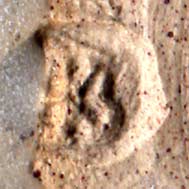
Fluted Pleydell-Bouverie pot (mark)

Fluted Pleydell-Bouverie pot (mark)
See also:
Fluted Pleydell-Bouverie pot (mark)
Pleydell-Bouverie, Katharine
Katharine Pleydell-Bouverie, known to her friends as Beano, was born in 1895. She became interested in ceramics after seeing pots by Roger Fry, and enrolled in classes at the Central School of Art under Dora Billington. In 1924 she became one of Bernard Leach's first students at St Ives. During her year at the Leach Pottery she came into contact with Cardew, Hamada, her good friend Norah Braden and one of her greatest influences, Matsubayashi.
After a year at St Ives she started her own pottery, the Cole Pottery, in the grounds of her family's estate at Coleshill, Berkshire. Here she started her life-long career of making and perfecting ash-glaze pots. She was a diligent note-taker and -maker, and meticulously wrote down all she heard at the many talks she attended at the Leach Pottery and elsewhere. Her knowledge of ash glazes became vast and Leach himself came to her many years later for advice on the subject. The setting at Coleshill was ideal for a pottery; there was an abundance of clay, water and trees to provide the large quantities of wood to fire the double-chamber kiln that Katharine had built with the help of her friend Ada 'Peter' Mason. In 1928 after Mason had left for the USA, Norah Braden joined Beano and stayed at Coleshill for eight years. Cole Pottery was active until the outbreak of the Second World War when it had to close in order to comply with blackout restriction. The firings took thirty-six hours, so it was impossible to confine them to the hours of daylight. Pleydell-Bouverie's best work was produced at Coleshill.
After the war the family estate was sold and Katharine moved to Kilmington Manor in Wiltshire. Norah Braden helped her build an oil-fired kiln that gave good service for fifteen years, after which it was replaced by a smaller electric kiln. She stayed at Kilmington Manor until her death in 1985.
Coming from an aristocratic and wealthy family, Pleydell-Bouverie never had to worry about making a living from her pots. Every pot she made and every glaze she experimented on was done for the love of the pursuit, and this shows in the 'humane' quality of her work. Her glazes were very well documented and have been a source of inspiration and study for many potters.
| Further Reading: | Katharine Pleydell-Bouverie by Barley Roscoe (Editor) |

